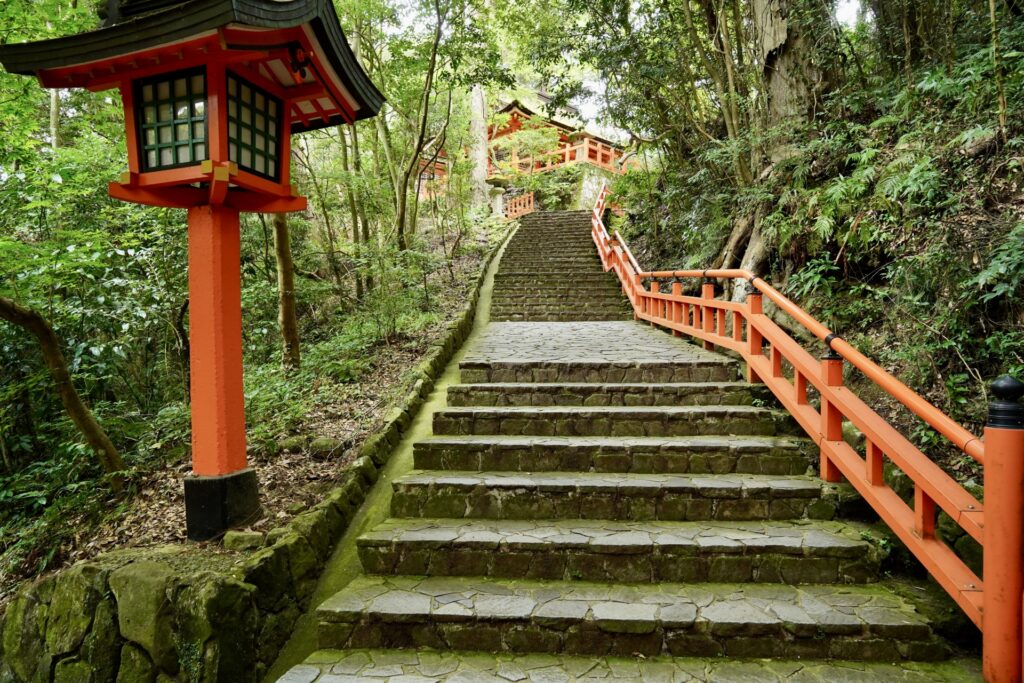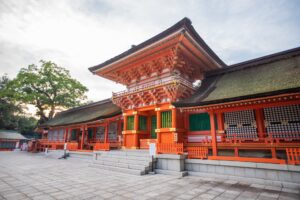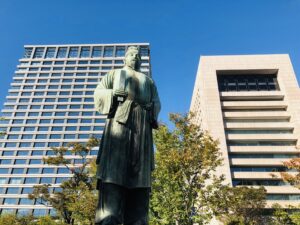Wake no Kiyomaro’s Legacy – From Usa Hachiman to Bushidō
和気清麻呂の後世への影響 ― 宇佐八幡と武士道への継承
Climbing the stone steps to Usa Hachiman Shrine is more than a physical journey—it is a symbolic ascent toward Japan’s spiritual heart. Each step recalls centuries of devotion, where pilgrims sought protection for the nation and strength to uphold the unbroken imperial line.

A moss-covered stone stairway lined with red railings and lanterns leading up to Usa Hachiman Shrine in Kyushu, Japan. The path symbolizes centuries of pilgrimage and devotion to the guardian of Japan’s imperial line.
Introduction – A Legacy Beyond a Lifetime
The courage of Wake no Kiyomaro did not fade with his death. His defense of the imperial line and his devotion to the oracles of Usa Hachiman shaped Japan’s national identity for centuries to come. From the role of Hachiman as a guardian deity of the state to the moral discipline later embraced by the warrior class, Kiyomaro’s spirit continued to resonate through Japan’s history.
Usa Hachiman as a National Guardian
In the centuries after the Dōkyō incident, Usa Hachiman Shrine rose to prominence as one of the great pillars of Japan’s polity. Hachiman was revered not only as a god of war but also as a divine protector of the imperial house. Whenever the nation faced crisis—be it foreign invasion, internal strife, or famine—the court and people turned to Hachiman for guidance and strength.
This role was inseparable from Kiyomaro’s mission. By carrying the true oracle that denied Dōkyō the throne, he had forever linked the shrine with the defense of imperial legitimacy. In this way, Usa Hachiman became a symbol of both faith and political stability.
Seeds of Bushidō – Loyalty and Integrity
The values embodied by Kiyomaro also took root in the warrior class. As the samurai emerged as the nation’s defenders, they looked to examples of loyalty, integrity, and sacrifice. Kiyomaro’s willingness to endure exile and humiliation rather than betray the imperial line resonated with the ethos that would later be called Bushidō.
For the warriors, true strength was not found in conquest alone but in the discipline of the heart—remaining faithful even when faced with disgrace or death. In Kiyomaro’s story, they found a model of chūgi (loyalty) and meiyo (honor) that guided their own moral code.
The Echo of Continuity
Kiyomaro’s legacy illustrates a profound truth: legitimacy and moral authority outlast force and ambition. His life tied together shrine and state, faith and governance, morality and power. Centuries later, the same principles guided leaders, thinkers, and warriors who sought to preserve harmony between heaven, earth, and the people.
Conclusion – A Living Spirit in Japan’s Identity
The story of Wake no Kiyomaro is not confined to the eighth century. It continues to live in the role of Usa Hachiman as a guardian of the nation, in the ethos of Bushidō that shaped Japan’s warriors, and in the enduring principle that legitimacy rests on integrity, not ambition.
In defending the throne and enduring exile for truth, Kiyomaro planted seeds that blossomed into Japan’s moral foundation. His legacy teaches us that to safeguard a nation is not merely to wield power, but to preserve the heart that binds its people together.


